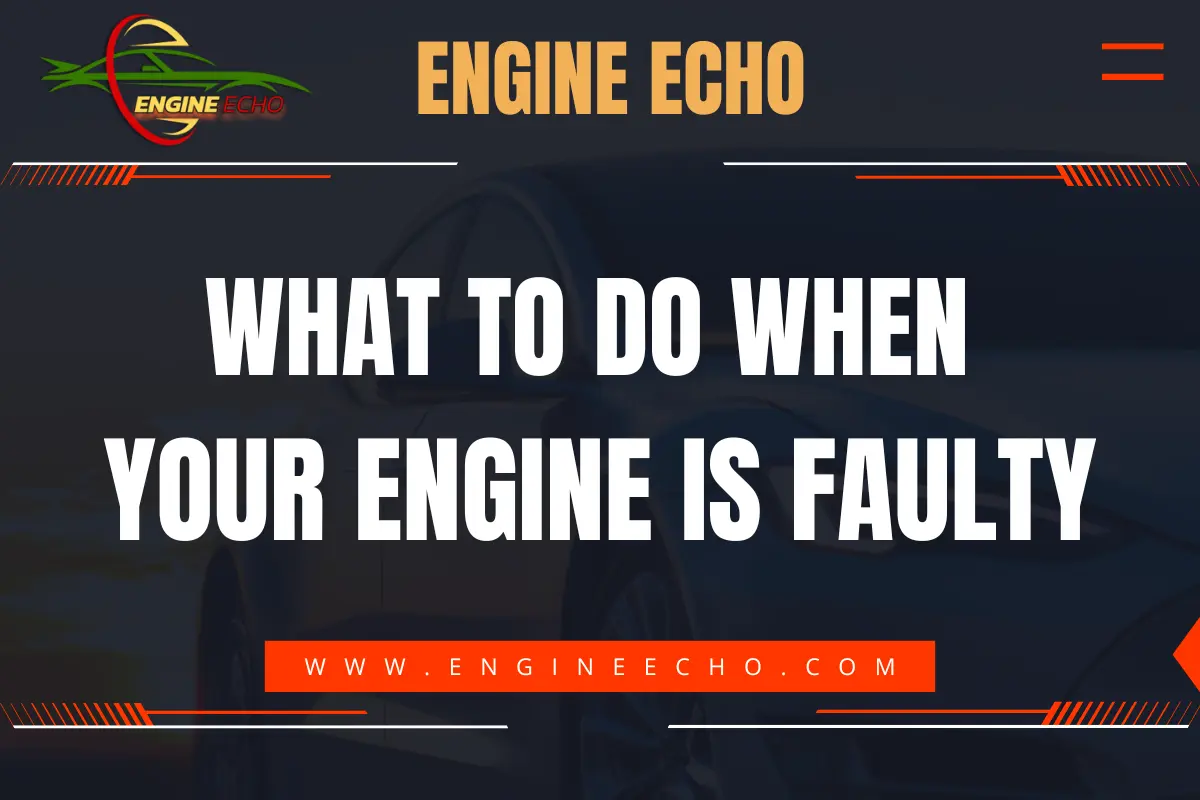What to Do When Your Engine is Faulty

Key Takeaways:
- Recognize early signs of engine trouble such as warning lights, strange sounds, or loss of power to prevent further damage.
- Use an OBD-II scanner to diagnose engine problems by reading error codes quickly and accurately.
- DIY fixes, such as replacing spark plugs or air filters, can solve minor engine issues and save repair costs.
- Major engine faults like persistent knocking or excessive smoke often require professional intervention.
- Preventive maintenance, including regular oil changes and coolant system checks, helps avoid costly engine repairs in the long run.
Introduction
We’ve all been there—one minute everything’s fine, and the next, that dreaded check engine light pops up. But don’t worry, you’re not alone, and knowing what to do next can save you from a lot of headaches. Whether it’s a small issue like a faulty spark plug or something more serious like overheating, acting quickly makes all the difference. I’ve been through it myself, and in this guide, I’ll share some tips that have helped me keep my car in check and avoid those massive repair bills.
1. Introduction to Engine Faults
An engine can be a bit unpredictable, no matter how well you take care of your car. “Faulty engine” covers everything from minor issues like a misfire to major problems like overheating. Trust me, engine problems can sneak up on you when you least expect them. The sooner you figure out what’s going on, the better—for both your car and your wallet.
Why Early Diagnosis Matters
- Helps prevent more extensive engine damage.
- Saves on costly repairs by addressing issues before they escalate.
2. Common Symptoms of Engine Faults
Recognizing engine issues early can save you from a world of hurt (and hefty mechanic bills). Here’s what to keep an eye out for:
Warning Lights on the Dashboard
- Check Engine Light: This is like your car’s way of saying, “Something’s up.” Don’t ignore it—grab an OBD-II scanner and find out what’s going on. I remember the first time I used one, and believe me, it made life so much easier by pointing me in the right direction.
- Oil Pressure Warning: Low oil pressure can do some serious damage. If this light comes on, check your oil level ASAP.
Unusual Sounds from the Engine
- Knocking: If you hear that dreaded knocking sound, don’t ignore it—it’s usually a sign something serious is brewing under the hood, like detonation.
- Grinding or Squealing: Failing belts or bearings often make these sounds, and they’re never a good sign. Trust me, you don’t want to wait until something snaps.
Loss of Power or Poor Performance
- If your car struggles to accelerate or just feels sluggish, that’s a red flag for issues with the fuel or ignition system. When my car struggled to gain speed on the highway, it turned out to be a simple fuel injector issue—but it could have been much worse if I had ignored it.
Excessive Smoke
- White Smoke: Could mean coolant is leaking into the engine—something you definitely don’t want to mess with.
- Blue Smoke: Usually points to burning oil, which could be a sign of worn-out seals or gaskets.
- Black Smoke: This often indicates your engine is burning too much fuel, possibly due to a clogged air filter or faulty fuel injector.
3. Initial Steps to Take When an Engine is Faulty
When something goes wrong under the hood, here’s what you should do immediately:
Turn Off the Engine Immediately
- Don’t push your luck! Turn off the engine to prevent further damage, even if you’re in the middle of a drive. Pull over somewhere safe if possible.
Check the Engine Oil Level
- I always make sure to check the oil first. Low oil levels can be the root cause of all sorts of engine issues. If it’s low, top it up, but if it keeps dropping, you might have a leak that needs fixing.
Inspect the Coolant System
- Overheating can ruin an engine fast. If you notice the temperature gauge creeping up, check your coolant levels. It’s saved me from a costly repair more than once.
4. Diagnostic Tools to Identify Engine Problems
Diagnosing engine problems isn’t as complicated as it seems, especially with the right tools.
Using an OBD-II Scanner
- An OBD-II scanner is a total lifesaver. Just plug it in, and you’ll get all the error codes right from your car’s computer, saving you a ton of time. The first time I used one, I was amazed at how quickly it zeroed in on the problem.
Manual Inspection Techniques
- Check Belts and Hoses: Give these a once-over for any signs of wear or leaks.
- Inspect for Visible Damage: If something looks off—whether it’s a leak or a loose part—address it right away.
5. Common Causes of Engine Faults
After a few years of tinkering with my own cars, I’ve found that engine issues typically come down to these areas:
Ignition System Issues
- Worn Spark Plugs: I’ve had my fair share of misfires from worn-out spark plugs. They’re easy to replace and can make a huge difference in how the car runs.
- Faulty Ignition Coils: These can be a bit tricky, but if your car’s having trouble starting or just feels off, they might be the culprits.
Fuel System Failures
- Clogged Fuel Injectors: These can make your engine run lean, reducing performance. A quick injector cleaning usually does the trick.
- Bad Fuel Pump: If your car isn’t getting enough fuel, you’ll notice sluggish performance or even stalling. That’s a job I usually leave to the pros, but catching it early can save you from being stranded.
Cooling System Malfunctions
- Thermostat Failure: If the thermostat gets stuck, the engine can overheat. Been there, done that—learned my lesson fast.
- Radiator Problems: A leaking or clogged radiator can prevent the engine from cooling properly, leading to overheating.
Exhaust System Problems
- Blocked Catalytic Converter: This will choke your engine’s power, making driving feel sluggish.
- Faulty Oxygen Sensor: This little guy controls your fuel mixture. If it’s off, so is your performance.
6. Fixing Minor Engine Faults at Home
You’d be surprised how many engine problems you can fix at home. Here are some DIY-friendly tasks that I’ve tackled successfully:
Replacing Spark Plugs and Ignition Coils
- Step-by-Step Process:
- Remove the old spark plug using a socket wrench.
- Replace it with a new plug, making sure it’s properly gapped.
- If necessary, install a new ignition coil.
- Doing this myself not only saved me money but also boosted my confidence in handling basic engine repairs.
Changing Air and Fuel Filters
- Keeping your filters clean is one of the easiest ways to keep your engine running smoothly. Fresh filters mean better air and fuel flow—and that’s good news for your engine’s performance. I make it a point to change mine every few months.
Fixing Minor Oil Leaks
- Tiny oil leaks? They’re usually easy to fix—just replace a gasket or seal, and you’re good to go.
7. When to Seek Professional Help
Not every engine problem is a DIY project. Knowing when to call in the pros is important:
Recognizing Severe Engine Issues
- Persistent Knocking: This isn’t something you want to ignore. If that knocking sound sticks around even after you’ve checked the usual suspects, it’s time to let a mechanic have a look.
- Engine Won’t Start: Sometimes, it’s more than just a dead battery or a fuel issue. If the engine refuses to start, leave it to the experts.
Cost-Benefit Analysis of DIY vs. Professional Repair
- Trust me, trying to fix a big problem without the right tools or know-how can backfire. It might cost more in the end, so sometimes it’s better to leave the heavy lifting to the pros.
8. Common Engine Repair Solutions
Here’s what you can expect when addressing engine issues:
Engine Tuning and Recalibration
- A well-tuned engine runs smoother and more efficiently. I’ve noticed a big improvement in fuel efficiency after having my engine recalibrated by a professional.
Rebuilding vs. Replacing the Engine
- Rebuild: I’ve had friends opt for an engine rebuild when certain parts wear out. It’s cheaper than a full replacement and keeps the car running smoothly.
- Replacement: Sometimes, though, the engine is beyond repair, and a replacement might be the only way to go. Sure, it’s not cheap, but if the rest of your car is in great shape, it’s definitely worth considering.
9. Preventive Maintenance to Avoid Engine Faults
The best way to avoid engine issues is by staying on top of regular maintenance:
Regular Oil Changes
- Stick to regular oil changes and use good quality oil—it’s the simplest way to keep everything running smoothly.
Keeping the Cooling System in Check
- Make sure to keep an eye on your coolant levels and look out for any leaks—trust me, it’s the easiest way to avoid an overheated engine.
Scheduled Engine Inspections
- Even if everything seems fine, have your engine inspected regularly. It’s those small, hidden problems that can become major headaches later on.
10. Case Studies: Real-Life Engine Faults and Repairs
Case 1: Overheating Due to a Failed Thermostat
- Issue: My car overheated constantly.
- Solution: A quick thermostat replacement did the trick. It’s one of those simple fixes that can save you from a massive headache down the road.
Case 2: Misfire Caused by Faulty Spark Plugs
- Issue: The car hesitated during acceleration.
- Solution: I replaced the spark plugs myself, and the difference in performance was night and day.
11. Tips for Buying a Car with a Faulty Engine
If you’re considering buying a car with engine issues, make sure to evaluate the repair costs before making a decision.
How to Evaluate Repair Costs
- Get an estimate from a mechanic, and compare it to the car’s value. Sometimes it’s worth it, but other times, you’re better off walking away.
Engine Rebuild or Swap Options
- I’ve seen cases where rebuilding or swapping the engine made the car a fantastic deal. Just be sure you know what you’re getting into.
12. Future Trends in Engine Diagnostics and Repair
The future of engine diagnostics is exciting—AI-powered tools are becoming more accessible, helping drivers like us diagnose problems faster and more accurately than ever. And with electric vehicles becoming more common, engine maintenance is also evolving. While electric engines require less maintenance, they still come with their own set of challenges that we’ll need to adapt to.
Conclusion
When your engine is faulty, it’s easy to feel overwhelmed, but trust me, with a little knowledge and some quick action, you can handle most minor issues on your own. Whether you’re replacing a spark plug or seeking professional help for a bigger problem, the key is to act early and stay on top of regular maintenance. Doing so will save you time, money, and a lot of headaches down the road.
Frequently Asked Questions (FAQs)
Q1: How do I know if my engine is faulty?
A: Common signs include the check engine light turning on, unusual noises from the engine, loss of power, or excessive smoke.
Q2: Can I fix a faulty engine at home?
A: Minor issues like replacing spark plugs or fixing small oil leaks can be handled at home, but major repairs should be left to professionals.
Q3: What does a knocking sound from the engine mean?
A: Knocking often indicates detonation or worn engine parts and should be addressed by a mechanic as soon as possible.
Q4: How often should I change my engine oil?
A: It’s generally recommended to change your oil every 3,000 to 5,000 miles, but check your vehicle’s manual for specific guidelines.
Q5: What should I do if my engine overheats?
A: Turn off the engine immediately, check the coolant levels, and allow the engine to cool before inspecting for leaks or damaged parts. Seek professional help if the issue persists.
Thanks for checking out this article on EngineEcho.com! Hope you found this article: "What to Do When Your Engine is Faulty" helpful! If you liked it and want to dive into more car engine topics, head over to our homepage. There's always something new to discover in the world of engines. Enjoy your reading journey!
Check out our previous article: Top Engine Oil Additives for Better Engine Health






